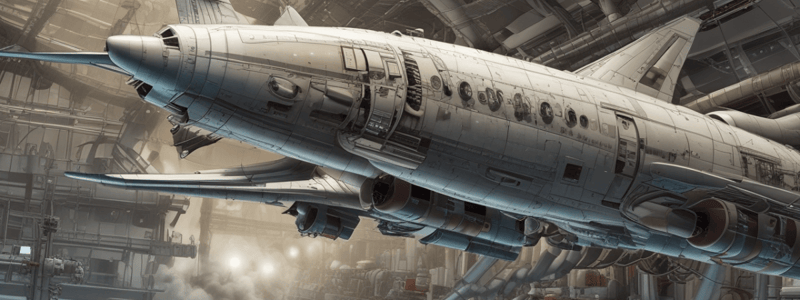Podcast
Questions and Answers
What is the primary function of a relief valve in a hydraulic system?
What is the primary function of a relief valve in a hydraulic system?
- To prevent pressure buildup (correct)
- To regulate flow rate
- To increase pressure
- To filter contaminants
What happens when fluid attempts to flow in the opposite direction in a ball check valve?
What happens when fluid attempts to flow in the opposite direction in a ball check valve?
- The pressure developed helps to hold the ball on its seat (correct)
- The ball is lifted off its seat
- The spring is compressed
- The valve fails to operate
What is the purpose of a thermal relief valve?
What is the purpose of a thermal relief valve?
- To relieve excessive pressure due to thermal expansion (correct)
- To regulate system pressure
- To filter contaminants
- To relieve pressure buildup due to pump failure
Which type of valve is used to bypass pump delivery pressure to the reservoir?
Which type of valve is used to bypass pump delivery pressure to the reservoir?
What is the purpose of a system relief valve?
What is the purpose of a system relief valve?
What happens when the valve poppet is forced off its seat in a thermal relief valve?
What happens when the valve poppet is forced off its seat in a thermal relief valve?
What is the main difference between a system relief valve and a thermal relief valve?
What is the main difference between a system relief valve and a thermal relief valve?
Why are relief valves commonly used in hydraulic systems?
Why are relief valves commonly used in hydraulic systems?
What is the purpose of a pressure regulator valve in a closed-centre hydraulic system?
What is the purpose of a pressure regulator valve in a closed-centre hydraulic system?
What is the function of the check valve in the simple regulator system?
What is the function of the check valve in the simple regulator system?
What is special about the MS 28889 valve compared to the AN 6287-1 valve?
What is special about the MS 28889 valve compared to the AN 6287-1 valve?
What is the purpose of the roll pin on the MS 28889 valve?
What is the purpose of the roll pin on the MS 28889 valve?
What happens when the accumulator is full and pressure builds up in the system?
What happens when the accumulator is full and pressure builds up in the system?
What is the other name for the MS 28889 valve?
What is the other name for the MS 28889 valve?
What is one of the functions of the reservoir in a hydraulic system?
What is one of the functions of the reservoir in a hydraulic system?
What happens to the fluid in the reservoir when accumulators, actuating cylinders, and other units are not containing their maximum quantities of fluid?
What happens to the fluid in the reservoir when accumulators, actuating cylinders, and other units are not containing their maximum quantities of fluid?
What is the purpose of standpipes in hydraulic reservoirs?
What is the purpose of standpipes in hydraulic reservoirs?
Where is the emergency fluid drawn from when system fluid is lost in hydraulic systems?
Where is the emergency fluid drawn from when system fluid is lost in hydraulic systems?
What is one of the functions of the reservoir in terms of air in the system?
What is one of the functions of the reservoir in terms of air in the system?
What is the purpose of the power pump in the hydraulic system?
What is the purpose of the power pump in the hydraulic system?
What is one of the functions of the reservoir in terms of system leakage?
What is one of the functions of the reservoir in terms of system leakage?
What is a common feature of sophisticated hydraulic reservoir designs?
What is a common feature of sophisticated hydraulic reservoir designs?
What is a major problem caused by foreign particles in the internal passageways?
What is a major problem caused by foreign particles in the internal passageways?
What is a major advantage of quick disconnect couplings?
What is a major advantage of quick disconnect couplings?
What is the main feature of screw type fittings?
What is the main feature of screw type fittings?
What is the purpose of the indicating pins on quick threading couplings?
What is the purpose of the indicating pins on quick threading couplings?
How do Inst-O-Matic hydraulic couplings operate?
How do Inst-O-Matic hydraulic couplings operate?
What is the function of the self-sealing valve located inside the quick disconnect fitting?
What is the function of the self-sealing valve located inside the quick disconnect fitting?
How many types of quick disconnect fittings are mentioned in the text?
How many types of quick disconnect fittings are mentioned in the text?
What is the purpose of the indicator pin on an Inst-O-Matic coupling?
What is the purpose of the indicator pin on an Inst-O-Matic coupling?
Where is the dial indicator mounted to provide reservoir fluid quantity indication?
Where is the dial indicator mounted to provide reservoir fluid quantity indication?
What is the purpose of the micro switch in the low fluid level detection system?
What is the purpose of the micro switch in the low fluid level detection system?
What type of pump is used in the engine driven pump (EDP)?
What type of pump is used in the engine driven pump (EDP)?
What is the purpose of the non-return valve in the engine driven pump (EDP)?
What is the purpose of the non-return valve in the engine driven pump (EDP)?
What are the three flexible hoses connected to the engine driven pump (EDP) for?
What are the three flexible hoses connected to the engine driven pump (EDP) for?
Where is the accumulator located?
Where is the accumulator located?
What is the purpose of the accumulator in the hydraulic system?
What is the purpose of the accumulator in the hydraulic system?
How is the engine driven pump (EDP) secured to the gearbox?
How is the engine driven pump (EDP) secured to the gearbox?
What is the main difference between hydraulic and pneumatic systems?
What is the main difference between hydraulic and pneumatic systems?
What is the branch of physics that hydraulic systems belong to?
What is the branch of physics that hydraulic systems belong to?
What is the earliest known application of fluid power?
What is the earliest known application of fluid power?
What is the purpose of hydraulic systems in aircraft?
What is the purpose of hydraulic systems in aircraft?
What is the principle that hydraulic systems operate on?
What is the principle that hydraulic systems operate on?
What is the main advantage of hydraulic systems?
What is the main advantage of hydraulic systems?
What is the term for the use of pressurised liquid to generate, control and transmit power?
What is the term for the use of pressurised liquid to generate, control and transmit power?
What is one of the ways accumulators act as a cushion or shock absorber in hydraulic systems?
What is one of the ways accumulators act as a cushion or shock absorber in hydraulic systems?
What is a characteristic of piston type accumulators?
What is a characteristic of piston type accumulators?
What is a component of a diaphragm accumulator?
What is a component of a diaphragm accumulator?
What is a function of accumulators in hydraulic systems?
What is a function of accumulators in hydraulic systems?
What are the two main types of accumulators used on aircraft?
What are the two main types of accumulators used on aircraft?
What is a component of a piston accumulator?
What is a component of a piston accumulator?
What is a characteristic of diaphragm accumulators?
What is a characteristic of diaphragm accumulators?
What do accumulators supplement in hydraulic systems under peak load conditions?
What do accumulators supplement in hydraulic systems under peak load conditions?
What is the primary characteristic of a fixed delivery pump?
What is the primary characteristic of a fixed delivery pump?
What is the function of the universal link in a fixed delivery pump?
What is the function of the universal link in a fixed delivery pump?
What is the purpose of the slots in the valve plate?
What is the purpose of the slots in the valve plate?
How do the pistons move in a fixed delivery pump?
How do the pistons move in a fixed delivery pump?
What is the angle of rotation between the drive shaft and the cylinder block?
What is the angle of rotation between the drive shaft and the cylinder block?
What is the component that connects the pistons to the drive shaft?
What is the component that connects the pistons to the drive shaft?
What is the purpose of the cylinder block?
What is the purpose of the cylinder block?
What is the result of the pistons moving outward from the cylinder block?
What is the result of the pistons moving outward from the cylinder block?
What happens when the axis of the cylinder block is parallel to the axis of the drive shaft in a variable delivery pump?
What happens when the axis of the cylinder block is parallel to the axis of the drive shaft in a variable delivery pump?
How does the swash plate type variable delivery piston pump operate?
How does the swash plate type variable delivery piston pump operate?
What is the purpose of a variable delivery pump?
What is the purpose of a variable delivery pump?
What is the correct procedure to deflate an accumulator using an AN 6287-1 valve?
What is the correct procedure to deflate an accumulator using an AN 6287-1 valve?
What is the effect of changing the alignment of the rotational axis of the cylinder block in a variable delivery pump?
What is the effect of changing the alignment of the rotational axis of the cylinder block in a variable delivery pump?
What is the main difference between the AN 6287-1 valve and the MS 28889 valve?
What is the main difference between the AN 6287-1 valve and the MS 28889 valve?
What is the purpose of the roll pin on the MS 28889 valve?
What is the purpose of the roll pin on the MS 28889 valve?
What is the function of the pistons in a multiple-piston variable delivery pump?
What is the function of the pistons in a multiple-piston variable delivery pump?
What happens when the accumulator is full and pressure builds up in the system?
What happens when the accumulator is full and pressure builds up in the system?
What is the difference between a multiple-piston variable delivery pump and a swash plate type variable delivery pump?
What is the difference between a multiple-piston variable delivery pump and a swash plate type variable delivery pump?
What is another name for the MS 28889 valve?
What is another name for the MS 28889 valve?
What is the result of the pistons moving within their respective cylinders in a variable delivery pump?
What is the result of the pistons moving within their respective cylinders in a variable delivery pump?
What is the purpose of the rotating swash plate in a swash plate type variable delivery pump?
What is the purpose of the rotating swash plate in a swash plate type variable delivery pump?
What is the purpose of the pressure regulator valve in a closed-centre hydraulic system?
What is the purpose of the pressure regulator valve in a closed-centre hydraulic system?
What is the function of the check valve in the simple regulator system?
What is the function of the check valve in the simple regulator system?
What is the purpose of tightening the swivel nut on the AN 6287-1 valve?
What is the purpose of tightening the swivel nut on the AN 6287-1 valve?
Flashcards are hidden until you start studying
Study Notes
Hydraulic System Components
- Fluid flows from the reservoir to the power pump, where it is forced through the system and eventually returns to the reservoir.
- The reservoir ensures a good supply of fluid to the pump, caters for ram displacement, allows for thermal expansion, provides a reserve of fluid for small leakage, and provides a means of filling and checking the system.
Reservoir Functions
- Stores unused fluid when accumulators, actuating cylinders, and other units are not containing their maximum quantities of fluid.
- Provides a reserve of fluid to meet all requirements when the maximum amount of fluid is being used in the system.
- Equipped with standpipes in systems that require a reserve of fluid for emergency operation of landing gear, flaps, etc.
Ball Check Valve
- Installed with a spring to hold the ball or cone on its seat whenever there is no flow.
- When fluid attempts to flow in the opposite direction, the pressure developed helps to hold the ball or cone on its seat and creates a tighter seal.
Relief Valves
- Pressure-operated valves that bypass pump delivery pressure to the reservoir.
- Used to prevent pressure from building to a point where it might blow seals, burst or damage components within the hydraulic system.
- Types of relief valves include system relief valves, thermal relief valves, and simple ball type relief valves.
Pressure Regulator Valves
- Required in closed-centre hydraulic systems to maintain pressure within a specified range and to keep the pump unloaded when no unit is being actuated.
- The most simple pressure regulator is the balanced type, which operates by maintaining a balance of forces between the pump pressure and the accumulator pressure.
Quick Disconnect Couplings
- Development is directly related to the advent of compact high-performance aircraft and aerospace ground equipment.
- Advantages include ease and speed of connecting and disconnecting plumbing systems, and elimination of system fluid or gas loss.
- Types of quick disconnect fittings include screw type, quick threading, and Inst-O-Matic.
Engine Driven Pump (EDP)
- Located in the rear fuselage and driven by the No.1 engine gearbox.
- Connected to the hydraulic system by three flexible hoses fitted with self-sealing quick release couplings.
- The three hoses are: suction (supply from the reservoir), pressure (to the user services), and return / case drain (to the return line back to the reservoir).
Accumulator
- Located in the centre fuselage and consists of a cylinder and a freely floating separator piston.
- Stores energy and provides a reserve of fluid for the system.
Hydraulic Systems Introduction
- Hydraulic systems use pressurized liquid to generate, control, and transmit power.
- They are used in various applications in aircraft, including landing gear and flight control systems.
- Hydraulic systems belong to the branch of physics known as fluid power systems, which work by moving fluid.
- The fluid used in hydraulic systems is incompressible.
Hydraulic Principles Terminology
- Pascal's Law: not defined in this text, but it is a fundamental principle in hydraulics.
Mechanical Advantage
- Not defined in this text, but it refers to the ability of a system to multiply force or speed.
Hydraulic System Components
- Fixed delivery pumps:
- Deliver a fixed amount of fluid at a given number of revolutions per minute.
- Consist of a drive shaft, cylinder block, pistons, and a valving surface.
- Operate by rotating the cylinder block, causing pistons to move in and out of the cylinders.
- Variable delivery pumps:
- Designed to vary the volume of fluid being delivered at a given number of revolutions per minute.
- Can be multiple-piston or swash plate type.
- Multiple-piston type: alters the stroke of the pistons by changing the angle of the rotational axis of the cylinder block.
- Swash plate type: alters the stroke of the pistons by using a fixed and rotating swash plate.
Hydraulic Systems
- Layout: not described in this text.
- Operation: hydraulic systems use pressurized fluid to transmit power.
- Characteristics: not described in this text.
- Electrical system interface: not described in this text.
Accumulators
- Act as a cushion or shock absorber by absorbing pressure fluctuations in the system.
- Store enough fluid under pressure for emergency operation of certain actuating units.
- Supplement the hydraulic pump output under peak load conditions.
- Types: piston and diaphragm.
- Piston accumulator:
- Constructed of a metal cylinder, floating piston, air or nitrogen charging valve, and hydraulic fluid port.
- Requires less space than an equivalent diaphragm accumulator.
- Diaphragm accumulator:
- Constructed of a metal sphere, synthetic rubber diaphragm, air or nitrogen charging valve, and hydraulic fluid port.
Pressure Regulator Valves
- Required in closed-centre hydraulic systems to maintain pressure within a specified range and keep the pump unloaded when no unit is being actuated.
- Simple pressure regulator: balanced type, which operates by maintaining a balance of forces between the pressure in the system and the force on the piston.
Studying That Suits You
Use AI to generate personalized quizzes and flashcards to suit your learning preferences.




